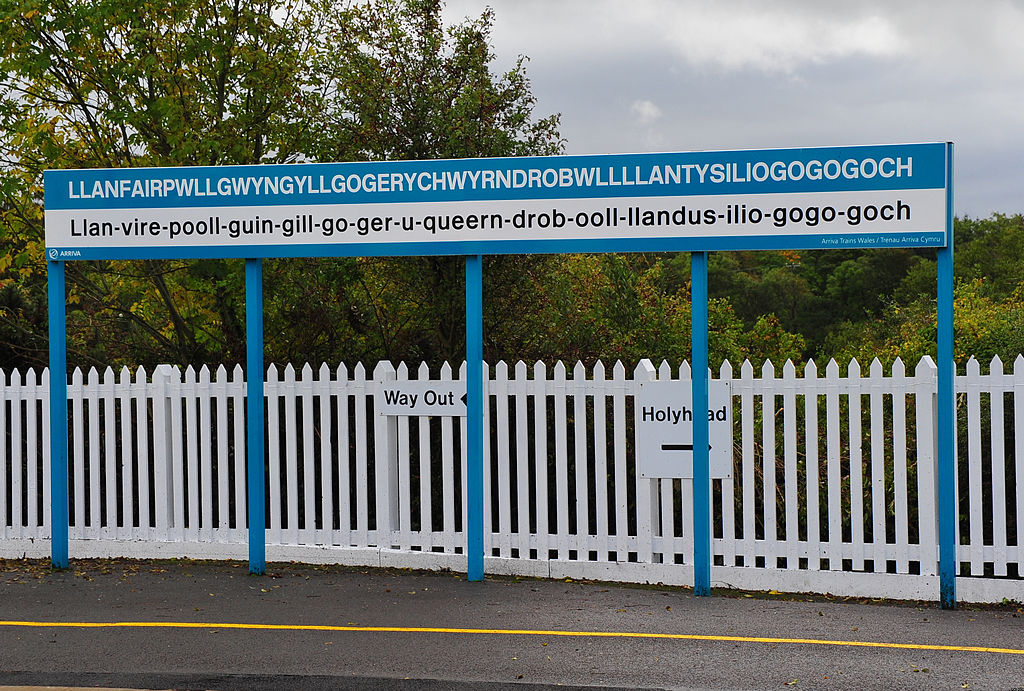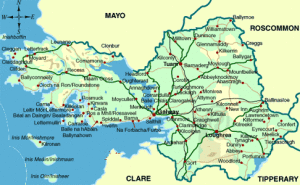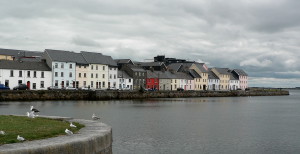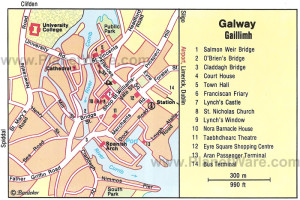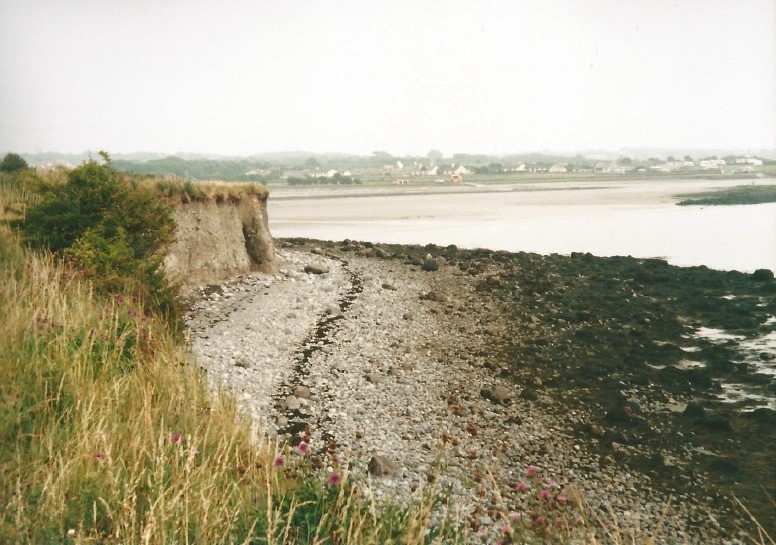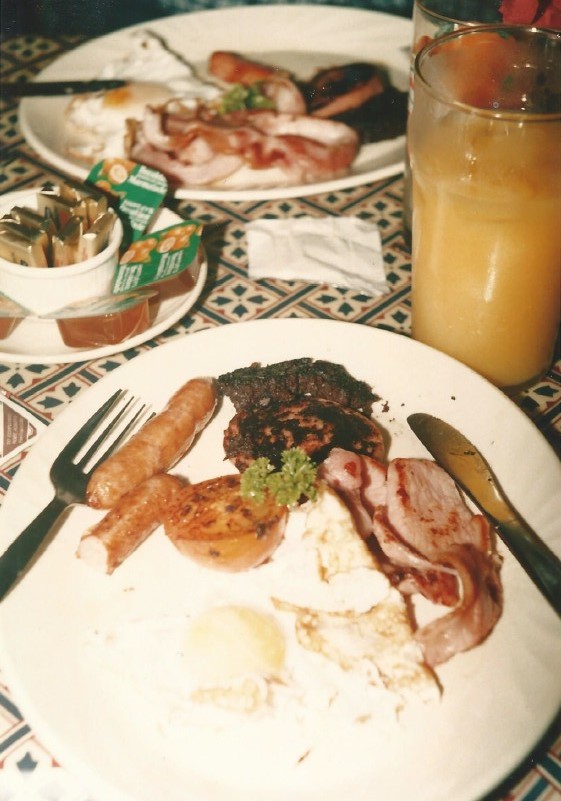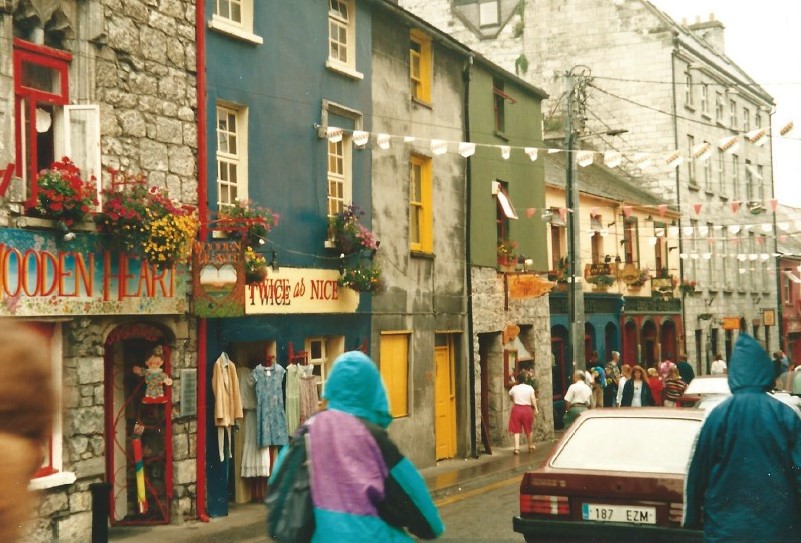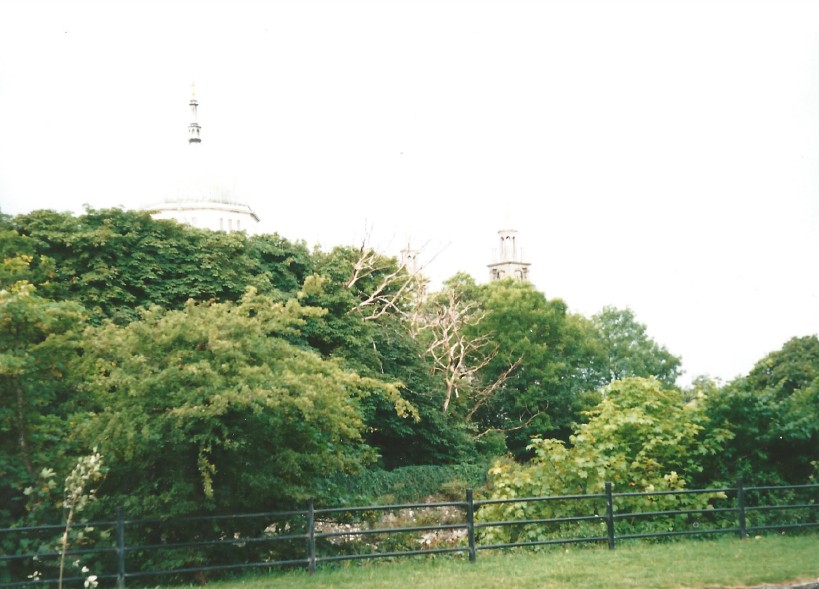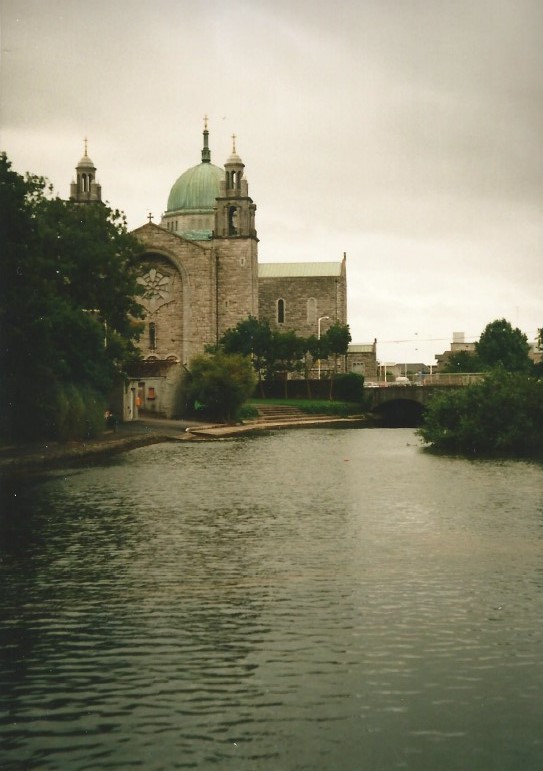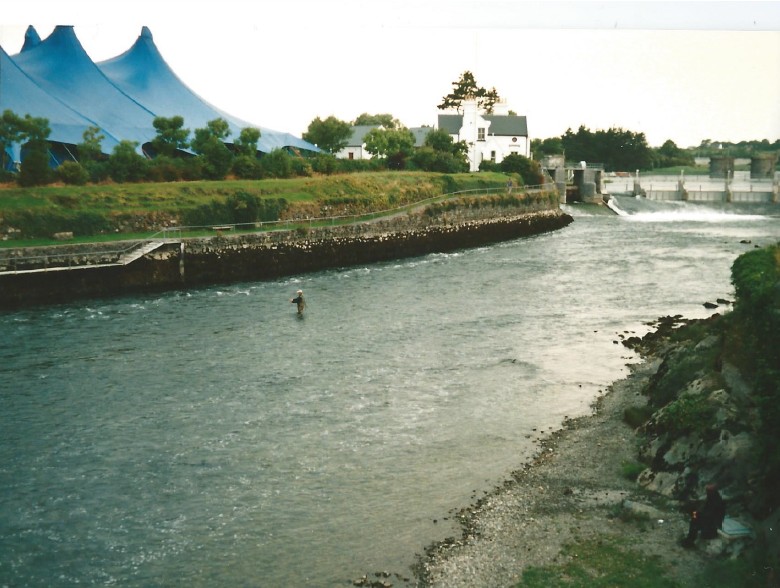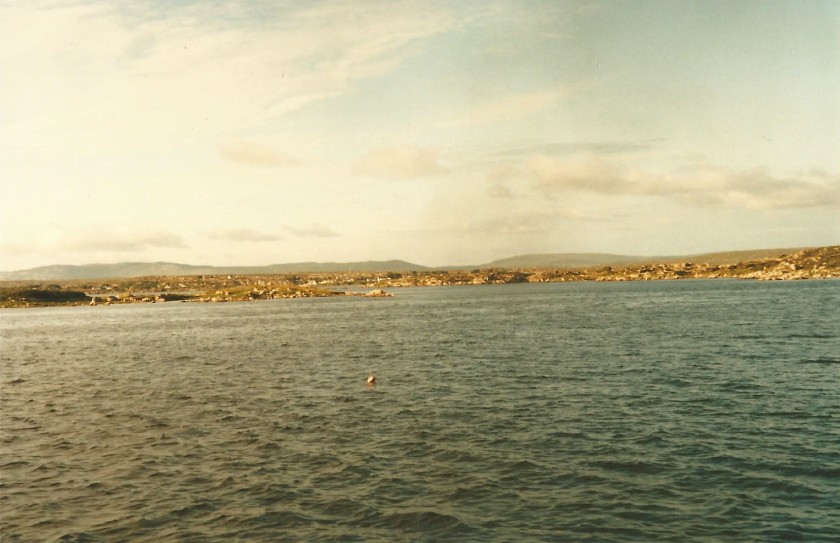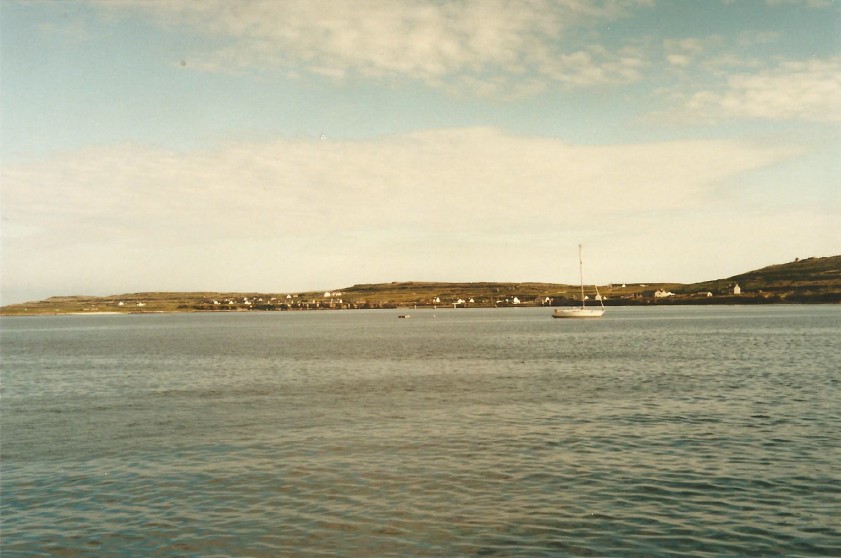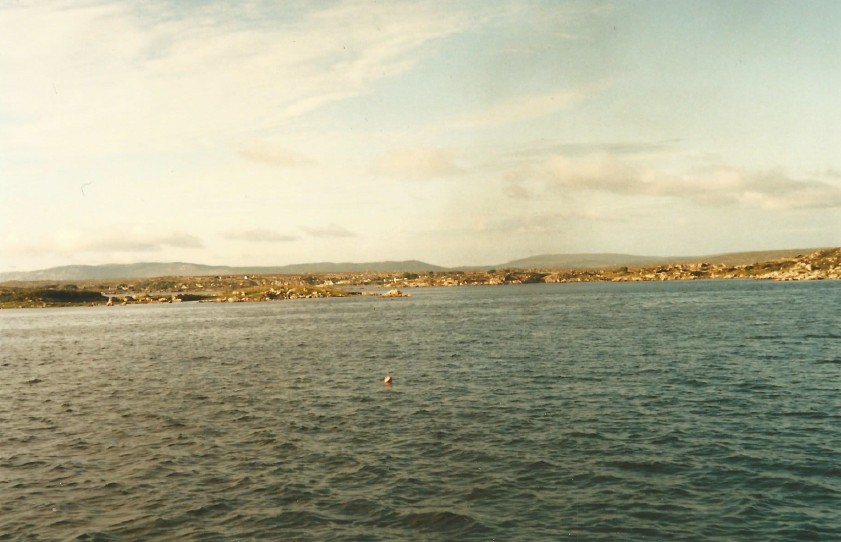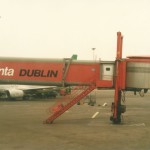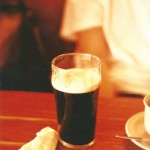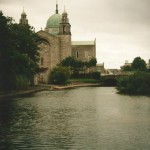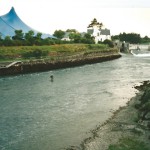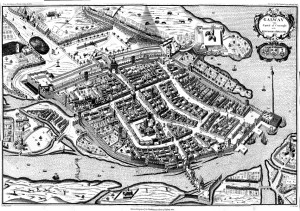1. Galway … and some minor language issues…
(The Wandelgek likes you, the reader of this blog to know that he advises you to read this blog aloud in the company of close friends. Maybe points for correct pronounciation could be awarded…)
After arriving at Dublin airport, The Wandelgek immediately went to the Heuston train station of Dublin and took a train westward. This track drives through the green, gentle rolling hills of the heart of Ireland. On his time table he saw the different names of stations of the villages and small towns he was passing through. He was reading his lonely planet travel guide and had skipped a few stations when he got curious of how far he had progressed and at the next station he looked at the station name sign which read:
Béal Átha na Sluaighe
Now…he had been to a lot of countries and he had experienced before that in some countries, names are written down differently in the local language then in the national language, but he was quite sure that he had never ever heard or seen anything vaguely familiar to this stations’ name. More so it hurt quite a bit when he bit his tongue trying to pronounce the name of this place. After questioning some fellow passengers, he could conclude that it was not he who stepped in the wrong train or before that in the wrong airplane ;-), but that the station name was in native Irish and not in English. The English name appeared to be Ballinasloe, which sounded strange to his ears, but which was a relief to pronounce after the previous name. All place names in Ireland are bi-lingual and when he looked better, he did see a second name underneath Béal Átha na Sluaighe. It seemed to him that this name was the longest place name or train station name he had ever seen and he had already travelled a lot.
After he returned home from this journey, the Wandelgek did some research in to these long names. He came up with this:
 This is the longest name of a place with a railway station. The name has 58 letters. And no he didn’t succeed in pronouncing this one either (it’s even difficult in English!)…
This is the longest name of a place with a railway station. The name has 58 letters. And no he didn’t succeed in pronouncing this one either (it’s even difficult in English!)…
The research went a little deeper and the result struck him with awe…

Longest place name in the world… (New Zealand) Notice how difficult it was to get this sign completely in the picture…
The pronounciation issues The Wandelgek had with this tongue breaker caused his tongue to go into shock…
But then going even more deeper into this hazardous topic, he found something which caused his jaw to drop to height of his shoes…
Someone actually did succeed in pronouncing this name without bleeding from his mouth and he was surprisingly happy…
This was very frustrating!
OK, the train did arrive at Galway station.
In Galway there was a great music festival going on, which was quit famous and was held there every year. This meant that a lot of backpackers and travelling musician were visiting Galway. it also meant that there was music on every streetcorner and in every pub. The wandelgek decided to stay for a few days, but it was too late to reach the nearest camping before dark, so he placed his tent on a pier in the harbour where more musicians and backpackers were sleeping. After placing the tent, he went downtown and mingled with the festival audience. In an Irish pub with a Celtic name that he cannot and doesn’t want to remember, but where it was so crowded that people were standing in crowds on the street, he ordered his first Guinness. It took 20 minutes to order the beer at the bar and 20 minutes to get it tapped and ready to drink. After that experience he adjusted his strategy to the local custom and ordered a second Guinness right after the delivery of the first. The
temperature was even after dark, warm and the air dry, so it was great to have a drink on the street. A street filled with street musicians and street artists doing there tricks and performances. There were Diabolo artists and jogglers. The monotonous sound of a a digereedoo made quite an impression. About eleven thirty the pubs were closing. The police checked wether pubs did really close the doors. The Wandelgek returned to the pier at the harbour. So now he was in Ireland, Land of the Kelts. He decided to check in at a real camping next morning.
Next day was quit a rainy and gray day. After checking in at a camping, The Wandelgek returned to down town Galway and started planning his itinary for the next three days. The plan was to first visit the Burren and the Cliffs of Moher, than to visit the island of Inishmore (part of the Aran Islands and third visit Clifden, a small town in the pastoral Connemara region.
The Wandelgek thought of Galway as a very pleasant, relaxed, but culturally and musically active small provincial town. Great places to get some rest are the Eyre Square in the Towns’ center and the harbour. In the small streets downtown are beautifull typically Irish bright colored houses with restaurants (many being fish restaurants because of the vicinity of the Atlantic Ocean), many shops and Irish pubs. The city is a fine hub from where to explore West Ireland.
Galway (Irish: Gaillimh, pronounced [ˈɡalʲɪvʲ]), or the City of Galway (Irish: Cathair na Gaillimhe), is a city in Ireland. It is in the West Region and the province of Connacht. Galway City Council is the local authority for the city. Galway lies on the River Corrib between Lough Corrib and Galway Bay and is surrounded by County Galway. It is the fourth most populous urban area in the Republic of Ireland and the sixth most populous city on the island of Ireland.
Etymology
The city takes its name from the river Gaillimh (River Corrib) that formed the western boundary of the earliest settlement, which was called Dún Bhun na Gaillimhe (“Fort at the mouth of the Gaillimh”). The word Gaillimh means “stony” as in “stony river” (the mythical and alternative derivations are given in History of Galway). Historically, the name was Anglicised as Galliv, which is closer to the Irish pronunciation as is the city’s name in Latin, Galvia.
In common with many ancient cities, Galway has its own origin myth. According to this mythic version, Galway is named after Gaillimh (Galvia), the daughter of a local chieftain, Breasail, who drowned in the River Corrib. The surrounding area became known as Áit Gaillimhe (Galway’s Place).
The city also bears the nickname “The City of the Tribes” (Irish: Cathair na dTreabh) because “fourteen tribes” of merchant families led the city in its Hiberno-Norman period. The term tribes was often a derogatory one in Cromwellian times. The merchants would have seen themselves as Irish gentry and loyal to the King. They later adopted the term as a badge of honour and pride in defiance of the town’s Cromwellian occupier.
Residents of the city refer to themselves as ‘Galwegians’ and, to a much lesser extent, ‘Tribesmen’.
History
Dún Bhun na Gaillimhe (“Fort at the Mouth (bottom) of the Gaillimh”) was constructed in 1124, by the King of Connacht, Tairrdelbach Ua Conchobair (1088–1156). Eventually, a small settlement grew up around this fort. During the Norman invasion of Connacht in the 1230s, Galway fort was captured by Richard Mor de Burgh, who had led the invasion. As the de Burghs eventually became Gaelicised, the merchants of the town, the Tribes of Galway, pushed for greater control over the walled city.
This led to their gaining complete control over the city and to the granting of mayoral status by the English crown in December 1484. Galway endured difficult relations with its Irish neighbours. A notice over the west gate of the city, completed in 1562 by Mayor Thomas Óge Martyn, stated “From the Ferocious O’Flahertys may God protect us”. A by-law forbade the native Irish (as opposed to Galway’s Hiberno-Norman citizens) unrestricted access into Galway, saying “neither O’ nor Mac shall strutte nor swagger through the streets of Galway” without permission. During the Middle Ages, Galway was ruled by an oligarchy of fourteen merchant families (12 of Norman origin and 2 of Irish origin). These were the “The Tribes of Galway”. The city thrived on international trade, and in the Middle Ages, it was the principal Irish port for trade with Spain and France. The most famous reminder of those days is ceann an bhalla (“the end of the wall”), now known as the Spanish Arch, constructed during the mayoralty of Wylliam Martin (1519–20). In 1477 Christopher Columbus visited Galway, possibly stopping off on a voyage to Iceland or the Faroe Islands. Seven or eight years later, he noted in the margin of his copy of Imago Mundi:
Men of Cathay have come from the west. [Of this] we have seen many signs. And especially in Galway in Ireland, a man and a woman, of extraordinary appearance, have come to land on two tree trunks [or timbers? or a boat made of such?]
The most likely explanation for these bodies is that they were Inuit swept eastward by the North Atlantic Current.
During the 16th and 17th centuries Galway remained loyal to the English crown for the most part, even during the Gaelic resurgence, perhaps for reasons of survival. However, by 1642 the city had allied itself with the Catholic Confederation of Kilkenny during the Wars of the Three Kingdoms. During the resulting Cromwellian conquest of Ireland, Cromwellian forces captured the city after a nine-month siege. At the end of the 17th century the city supported the Jacobites in the Williamite war in Ireland and was captured by the Williamites after a very short siege not long after the Battle of Aughrim in 1691. The great families of Galway were ruined, and, having declined owing to the potato famines of 1845–1852, the city did not fully recover until the great economic bubble of the late twentieth century.
Culture
Galway is known as Ireland’s Cultural Heart (Croí Cultúrtha na hÉireann) and is renowned for its vibrant lifestyle and numerous festivals, celebrations and events. Every November, Galway hosts the Tulca Festival of Visual Arts as well as numerous festivals.
In 2004, there were three dance organisations, ten festival companies, two film organisations, two Irish language organisations, 23 musical organisations, twelve theatre companies, two visual arts groups, and four writers’ groups based in the city.
Furthermore, there were 51 venues for events, most of which were specialised for a certain field (e.g. concert venues or visual arts galleries), though ten were described as being ‘multiple event’ venues. The main squares in the city are Eyre Square (containing John F. Kennedy Park) in the centre of the city, and Spanish Parade next to the Spanish Arch.
In 2007, Galway was named as one of the eight “sexiest cities” in the world. A 2008 poll ranked Galway as the 42nd best tourist destination in the world, or 14th in Europe and 2nd in Ireland (behind Dingle). It was ranked ahead of all European capitals except Edinburgh, and many traditional tourist destinations (such as Venice). The New Zealand Herald listed Galway as one of ‘five great cities to visit in 2014’. The others were Istanbul, New Orleans, Dubai and Cabo, Mexico.
Music
Galway has a vibrant and varied musical scene. As in most Irish cities traditional music is popular and is kept alive in pubs and by street performers. Notable bands from Galway include The Saw Doctors and The Stunning. Galway Early Music Festival presents European music from the 12th to the 18th century. It encourages not only music, but also dance and costumes. The festival involves both professional and amateur musicians.
Galway Cathedral Recitals is an international series of concerts of classical music which has taken place in Galway Cathedral each July and August since 1994.
A number of notable choirs are based in the city. They include Tribal Chamber Choir (founded in 2009) directed by Mark Keane; the Galway Baroque Singers (founded in 1983) directed by Audrey Corbett; Cois Cladaigh Chamber Choir (founded in 1982) directed by Brendan O’Connor, which sang at the inauguration of President Michael D. Higgins in St Patrick’s Hall, Dublin Castle, on November 11, 2011; Galway Gospel Choir (founded in 2001) directed By Michel Durham Brandt; and Galway Choral Association (founded in 1998) directed by Norman Duffy.
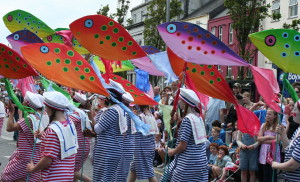
Street artists during the Galway Arts Festival in July…
The Galway Arts Festival (Féile Ealaíon na Gaillimhe) takes place in July. It was first held in 1978 and since then has grown into one of the biggest arts festivals in Ireland. It attracts international artists as well as providing a platform for local and national performers. The festival features parades, street performances and plays, musical concerts and comedy acts. Highlights of the festival tend to be performances by Macnas and Druid Theatre Company, two local performance groups. The Galway Youth Orchestra was formed in 1982.
The renowned folk and traditional singer Dolores Keane, lives in Galway.
Traditional Irish music
Galway city is a major centre for traditional Irish music. The traditional group De Dannan were based in Galway. Musicians such as Mickey Finn, Frankie Gavin, Johnny (Ringo) McDonagh and Alec Finn came to prominence in Galway. Carl Hession, a well known Irish composer, arranger and traditional musician also hails from Galway city.
[http://comhaltas.ie/ Comhaltas] branches operate in several parts of the city, teaching Irish Traditional Music to children. Dusty Banjos runs classes and sessions in the city for adults switching from other musical traditions to Irish Traditional Music, and for adult beginners and improvers who are not at a level where they could participate in general sessions.
Live Music venues
Traditional and contemporary music can be heard at numerous locations around the city. Among the more notable are The Crane Bar on Sea Road, The King’s Head on High Street, Tigh Neachtáin and The Quays on Quay Street, Róisín Dubh and Monroe’s Tavern on Lr Dominic Street.
Irish language
Galway City has a reputation among Irish cities for being associated with the Irish language, music, song and dancing traditions. It is sometimes referred to as the ‘Bilingual Capital of Ireland’, although like elsewhere in the Republic of Ireland, inhabitants converse mostly in English. The city is well known for its “Irishness”, mainly because it has on its doorstep the Galway Gaeltacht. Irish theatre, television and radio production and Irish music form a component of Galway city life, with both An Taibhdhearc, the National Irish Language Theatre, in Galway city itself, while TG4 and RTÉ Raidió na Gaeltachta headquarters are in the Connemara Gaeltacht elsewhere in County Galway. Four electoral divisions, or neighbourhoods (out of twenty-two), are designated as Gaeltachtaí. NUI Galway also holds the archive of spoken material for the Celtic languages.
The Claddagh
On the west bank of the River Corrib as it enters the sea is the ancient neighbourhood of The Claddagh. For centuries it was an Irish-speaking enclave outside the city walls. Claddagh residents were mainly fisher folk and were governed by an elected ‘King’. The King of the Claddagh settled or arbitrated disputes among the locals and had the privilege of a white sail on his fishing boat. The last true king, Martin Oliver, died in 1972. The title is still used but in a purely honorary and ceremonial context. The current King is Michael (Mike) Lynskey.
The area is also famous for it’s association with the Claddagh Ring.

